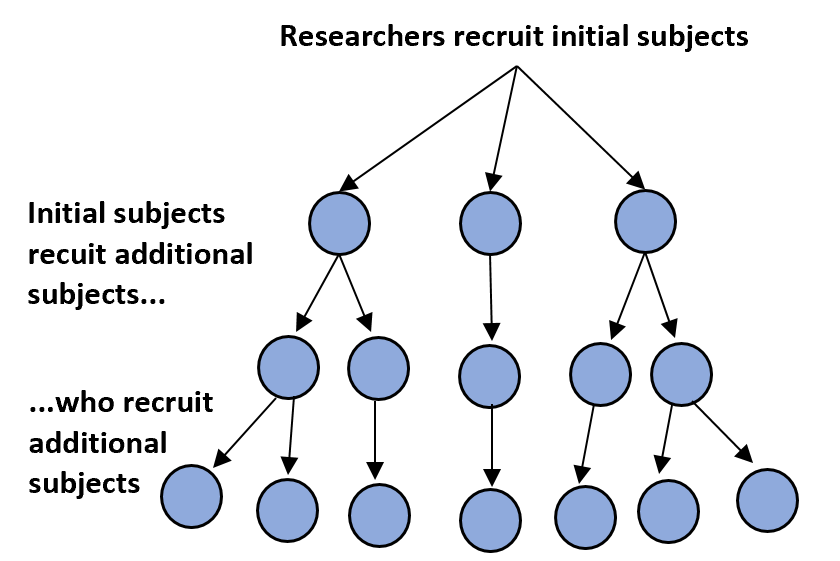When researchers are interested in studying a particular population, they often recruit members of the population to be in a study using some type of sampling method.
One such method is snowball sampling, a method in which researchers recruit initial subjects to be in a study and then ask those initial subjects to recruit additional subjects to be in the study.
Snowball sampling is also sometimes referred to as chain-referral sampling.
Using this approach, the sample size “snowballs” bigger and bigger as each additional subject recruits more subjects.
This sampling method is often used when researchers wish to study a population where the subjects are particularly hard to identify or reach. Examples include:
Individuals with rare diseases. If researchers are conducting a study of individuals with rare diseases, it may be difficult to find these individuals. However, if they can find just a few initial individuals to be in the study then they can ask them to recruit further individuals they may know through a private support group or through some other means.
Homeless individuals. It may be difficult to obtain a list of homeless individuals in a city. However, researchers could find a few homeless individuals and then ask them to recruit more individuals they know who are homeless to be involved in the study.
Ex-convicts. If researchers are interested in conducting a study of ex-convicts, it could be difficult to find a large sample of people who would be willing to come forward to be in the study. But if researchers can find just a few ex-convicts to be in the study, they could ask each of them to recruit additional people they may know who are also ex-convicts.
The reason snowball sampling is so effective is because it’s often difficult for researchers to recruit individuals who don’t want to be identified for a particular reason. However, it’s much easier to recruit these individuals if they’re being recruited by people who are in similar circumstances as them and can reassure them that their privacy will be maintained in the study.
A researcher might have a difficult time recruiting someone with a rare disease to be involved in a study, but if that person is being recruited by someone who has the exact same disease, they’re far more likely to oblige.
Technical Notes:
Snowball sampling is an exampling of a non-probability sampling method, which means that not every member in a particular population has an equal probability of being selected for a study.
After all, using this method, the only way that an individual could become part of a study is if they were recruited directly by a researcher to be an initial subject or if they were recruited by a subject that was already in the study.
The opposite of a non-probability sampling method would be a probability-based sampling method, in which each member of a population has an equal probability of being selected for a study. The most obvious example of this would be a simple random sample.
Advantages of Snowball Sampling
There are some advantages to using snowball sampling, including:
- Researchers can reach subjects in a particular population that would otherwise be difficult or impossible to reach.
- Snowball sampling is low-cost and easy to implement.
- Snowball sampling doesn’t require a research team to hire recruiters for the study since the initial subjects act as the recruiters who bring in additional subjects.
Disadvantages of Snowball Sampling
There are also several disadvantages to using snowball sampling, including:
- The sample for the study is not guaranteed to be a sample that is representative of the larger population.
- Sampling bias is likely to occur. Because initial subjects recruit additional subjects, it’s likely that many of the subjects will share similar traits or characteristics that might be unrepresentative of the larger population under study.
- Because the sample is likely to be biased, it can be hard to draw conclusions about the larger population with any confidence. For this reason, snowball sampling is often used as part of exploratory analysis – when researchers are simply interested in gaining a better understanding of a certain population and potentially uncovering information that they weren’t aware of.
The Ethics of Snowball Sampling
Because snowball sampling is often used to recruit individuals who don’t want to be identified or known, the topic of the research is usually sensitive and personal.
For this reason, researchers must be extra careful to protect the private information of the individuals in the study so that their contact details and information isn’t leaked.
The researchers should inform existing subjects and potential future subjects that all of their private information will be kept safe.



